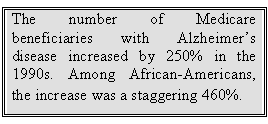COSTS OF DEMENTIA
The estimated economic costs of Alzheimer’s disease in the United States total at least $100 billion annually; it is considered the third most expensive disease to treat (16). Per patient costs for nursing home care alone for persons with AD range from $42,000 to $70,000 a year (17). In addition, it is estimated by a University of Pennsylvania study that the cost to business approaches $61 billion (18). The study, Alzheimer’sDiseases: The Costs to U.S. Businesses in 2002, breaks this figure down between health care for people with AD ($24.6 billion) and costs incurred by caregivers ($36.5 billion), which include absenteeism ($10 billion), productivity losses ($18 billion), and worker replacement costs ($6 billion).
As dementia, and AD in particular, is primarily an illness of the elderly,
the costs to Medicare are tremendous. The number of Medicare beneficiaries
with AD increased by 250% in the 1990s according to researchers at Duke
University (19). Among African-Americans, the increase was a staggering
460%. Medicare costs for AD patients are  nearly
three times higher than the average for all beneficiaries; it is estimated
that Medicare expenditures for AD will increase by 55% to $50 billion in
less than 10 years, while the costs to Medicaid will increase 80%, to $33
billion. To quote Sheldon Goldberg, the president and CEO of the Alzheimer’s
Association, “Unless a prevention or cure is found soon, Alzheimer’s
disease will overwhelm our already stretched health-care system and bankrupt
Medicare and Medicaid.”
nearly
three times higher than the average for all beneficiaries; it is estimated
that Medicare expenditures for AD will increase by 55% to $50 billion in
less than 10 years, while the costs to Medicaid will increase 80%, to $33
billion. To quote Sheldon Goldberg, the president and CEO of the Alzheimer’s
Association, “Unless a prevention or cure is found soon, Alzheimer’s
disease will overwhelm our already stretched health-care system and bankrupt
Medicare and Medicaid.”
The costs of treating AD increase with the severity of the disease. Leon et al. analyzed 1996 data and estimated (in 1996 dollars) the monthly costs of caring for a patient suffering from mild (early onset) AD to be $1,534, while the costs for someone with moderate AD was $2,054, and those for a patient with advanced AD was $3,011 (2). These costs have increased substantially since then, but indicate the increased care needed as AD progresses. More recently, researchers at Duke University estimated that direct medical costs for patients with advanced AD were 60% to 200% higher than for those with mild AD (19). The study found the highest costs to be incurred after a patient has had AD for 10 years. According to Henry Glick, the study’s lead author, “In women, it’s $30,000 a year among survivors if you survive 10 years and in men it’s $20,000.” The higher costs for women result from longer stays in nursing homes.
While the costs of treating vascular dementia were not found to be significantly different than those for treating AD in a research project by the Institute for the Study of Aging, the subgroup of patients with arteriosclerotic dementia/multi-infarct dementia had costs that were significantly higher ($10,555/year) than those with AD (20).